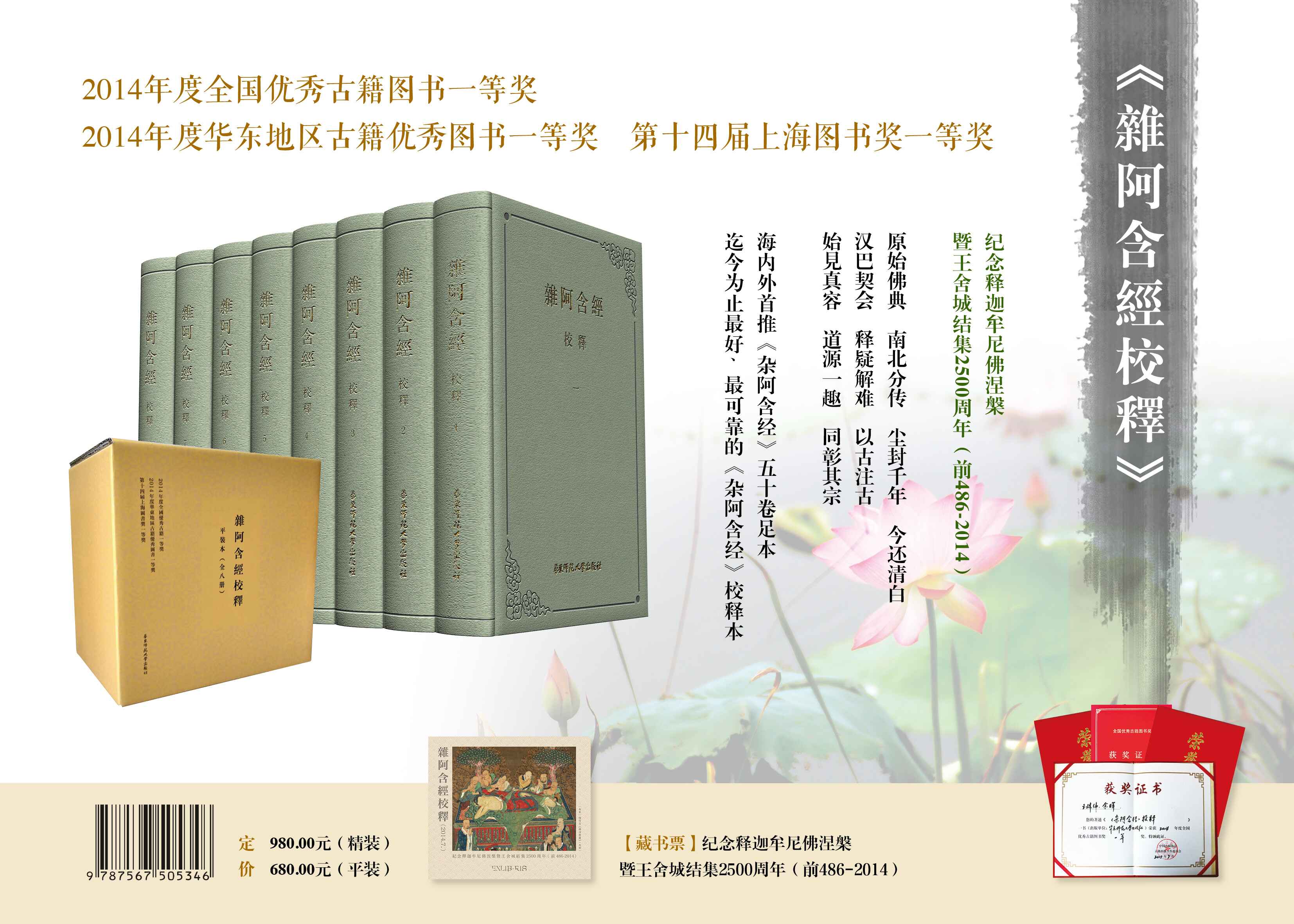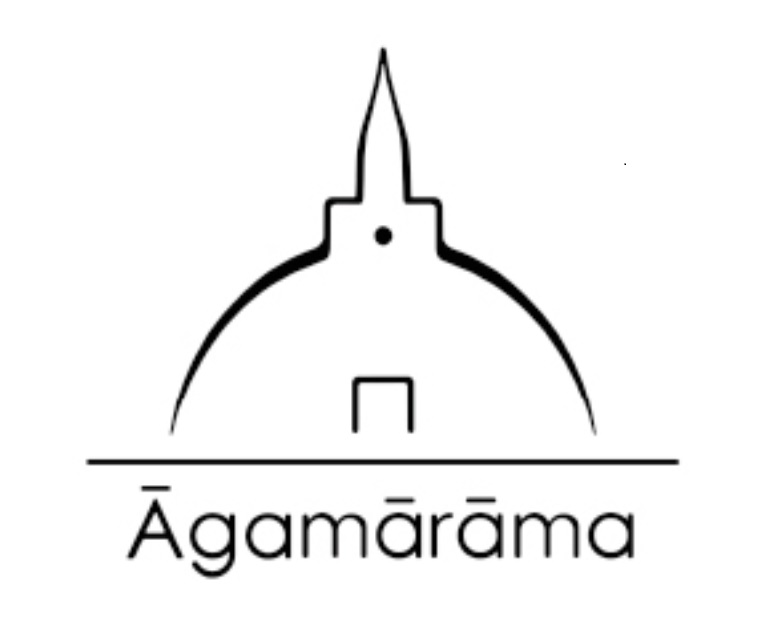
|
|
|
簡介 |
| 原始佛教在佛滅度一百年後產生部派,至西元前3世紀阿育王時遠播南北,其中上座部和有部所傳最力,南傳至斯裏蘭卡等 地(現存上座部完整三藏及 |
注疏),北傳至中國(現存有部經典最豐)。唐義淨(635—713)《南海寄歸傳》謂:南印乃至獅子國(今斯裏蘭卡)所傳皆上座部,北印及南海諸國(今東南亞)皆傳有部。二部盛極當年可見一斑。
漢譯《雜阿含經》為有部較早傳本,由法顯(337-422)從斯裏蘭卡取回,印度高僧求那跋陀羅(394-468)漢譯,是北傳四阿含中唯一梵出作品,被認為是最接近早期佛經原貌的佛陀言論集。而與之對應的南傳巴利本《雜尼迦耶》則完整保留了二千三百年前上座部佛經的原貌,是現存最古老的佛經。
惜此珍本自來中國,即以“小乘經”蒙塵,流轉千年,次第顛倒、經卷殘失、誤寫誤補、面目難辨。直至近代有呂澂、印順等前輩對此做了開創性的研究,《雜阿含經校釋》即在此基礎上努力拓展,以求還原。《校釋》主要成績有三:(1)編類補佚、勘訂足本。依玄奘(602-664)、義淨等譯典所記體例,重編類目、還原卷次;以《高麗藏》為底本,《房山石經》、《趙城藏》等近十種刻本為校本,輔以漢巴經論,校勘全文;由巴利本譯補兩卷佚經。(2)漢巴精對、以古注古。南以巴利三藏,北以本母、阿含異本、有部阿毗達磨、有部律書等文獻,互參匯注,不避不漏,集為詞典。(3)南北相較、證其同源。全面、深入比較研究漢巴早期經論,增改對經,記錄證據,顯示南北阿含實出同源,同期經典之詞、句、文、義皆具極高互釋性,令後期經典望塵莫及。
今由校勘、整編、補佚,全經總得四分、七誦、五十六集八千四百九十一經,由“修多羅”、“祇夜”、“記說”三分教攝。全書工程浩大、頭緒繁多,作者傾二人之力、盡十餘年告成,填補了《雜阿含經》乃至原始佛教研究領域的多項學術空白。本書校點恰當、譯語準確、注釋精細,不僅恢復了《雜阿含經》的原貌、疏通了經文的滯礙,更廓清了原始佛教的思想結構,令這部沉寂千年的古籍珍本重放光彩。
*** *** *** *** *** ***
Introduction
Original Buddhism evolved schools approximately 100 years after the parinirvana of the Buddha, and far transmitted southwards and northwards at the period of Ashoka (3th century BC), Theravada and Sarvastivada were most influential then, throughout south to Sri Lanka(the Tripitaka and notes and commentaries of Theravada still remains intact today), north to China (the extant texts of Sarvastivada are most abundant). Yijing (Tang dynasty, 635-713) has said in his A Record of the Buddhist Religion as practised in India and the Malaya Archipelago: All that is spreading in South India and Sinhala (Sri Lanka) is Theravada, and in North India and South Sea States(Southeast Asia) is Sarvastivada. The prevailing of these two sects at that time can be seen.
The chinese Samyuktagama is an early version of Sarvastivada, which was brought from Sri Lanka by Faxian(337-422), and translated by Indian eminent monk Gunabhadra(394-468). It's the only one from Sanskrit among the northern four Agamas, deemed to be the words of the Buddha which is most close to the Original Buddhism Texts. Correspondingly, the southern Pali version Samyutta Nikaya completely retains the original state of the Theravada’s Texts 2300 years ago, which is the earliest version among the extant Buddhism texts.Unfortunately, such a rare edition has been disgraceful because of its “Hinayana” status since coming to china. After thousand of years, its sequence was disarranged, scrolls were lost and became incomplete, coupled with wrong transcribing and wrong complement, which made it difficult to read.
Until modern times, Lucheng, Yinshun and other progenitors did a lot of pioneering research work on it. Just on the base of their work, this set of books the Collation and Annotation of Samyuktāgama made arduous efforts to extend the exploration in order to reach the truth.
There are three major achievements in this set of books:
1. Compile category and retrieve the lost, correct errors and complement the text. According to the styles recorded in Xuanzang(602-664) and Yijing’s translations recompiled the category and restored the order of scrolls. Using Tripitaka Koreana as master copy, Fangshan Stone carving Tripitaka, Zhaocheng Jin Tripitaka and so on about ten block-printed editions as proofreading copies, together with other scriptures and treatises both of chinese and Pali, collated the whole text, translated two lost scrolls from Pali Canon further to make the text complete.
2.Collate chinese version with Pali Canon carefully, annotate ancient texts with ancient texts. Collected Southern Pali Tripitaka , Northern Matika, the offprints and the various editions of Agama, Sarvastivada Abhidharma, Sarvastivada Vinayapitaka, etc, for cross-reference and variorum gloss, without ignoring or omitting, integrated them all into the dictionary.
3.Compare the southern with the northern, prove the same source of them. Studied the early texts of Pali Canon and Chinese versions fully and deeply, complemented and corrected the corresponding sutras, recorded all the traces and evidences, which demonstrate the northern Agama and the southern Nikaya are from the same source, the words and sentences, the grammar and meaning of contemporary texts prove each other strongly,while those later texts are far less.
Through collation, reorganization and addendum, the whole text consists of 4 parts, 7 chapters, 56 samyuktas and 8491 sutras, divides into 3 categories: sutra, geya and vyakarana. The compiling of this set of books is a huge and complex project, the authors did their utmost, spent more than fourteen years to complete it, filling many gaps in research fields of Samyuktagama and even Original Buddhism . This set of books are collated and punctuated correctly, translated accurately, and annotated detailedly, not only restores Samyuktāgama to original, clears out all the obstacles in texts, but also outlines and sharpens the frame of Original Buddhism idea, makes this rare ancient edtion which has been ignored for thousand of years, renovated and dignified again.
|
Dedicated to the memory of the 2500th Anniversary of Buddha’s Nirvana and the First Buddhist council at Rajgir (486 B.C-2014 A.D) - the publication of the Collation and Annotation of Samyuktāgama in July 2014. This work is a funded project by Shanghai Publishing Funds in 2013, the first prize winners both of the National Excellent Ancient Book Award and the Excellent Ancient Book Award in East China in 2014, and the first prize winner of the 14th Shanghai Book Award. |
|
【作者簡介】 王建伟(1958~)、金晖(1971~),毕业于华东师范大学,师从斯里兰卡凯拉尼亚大学(University of Kelaniya-Sri Lanka)尊者达默迪纳博士(Ven. Dr. Dhammadinna )学习巴利经典,深入南北传佛教思想、历史之比较研究。2000年初至今 ,十余年专研《杂阿含经》及相关汉、巴原始经论, 完成《杂阿含经校释》(2014年付梓)。创立阿含学苑(Āgamārāma),有《来果禅师年谱》、《生命的真意》等多种著、译作品于海内外出版。
|
|

